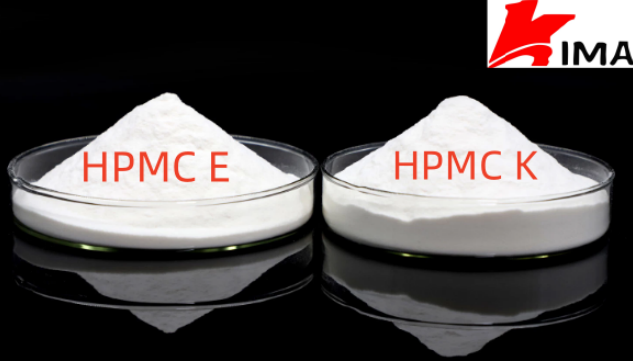HPMC (Hydroxypropyl Methylcellulose) is a commonly used semi-synthetic polymer compound, widely used in pharmaceutical, food, cosmetics and other fields. The chemical structure of HPMC is made soluble and biodegradable by introducing hydroxypropyl and methyl groups into natural cellulose molecules. According to different physical and chemical properties, HPMC can be divided into multiple types, among which HPMC E and HPMC K are two common varieties, and their main differences are reflected in molecular weight, viscosity, solubility and other aspects.

1. Molecular weight difference
The molecular weight of HPMC is an important factor affecting its performance. HPMC E and HPMC K have different molecular weights, which directly affects their viscosity, dissolution rate and stability.
HPMC E: Usually belongs to low molecular weight HPMC, with a molecular weight range of approximately 50,000-100,000. Due to its lower molecular weight, HPMC E dissolves faster in water and is suitable for applications that require faster dissolution or lower rheological properties.
HPMC K: HPMC with a higher molecular weight, usually ranging from 100,000 to 300,000. HPMC K has a higher molecular weight, which results in a slower dissolution rate and higher viscosity, making it suitable for applications that require higher viscosity and stability.
2. Viscosity Differences
The viscosity of HPMC is closely related to its molecular weight. The higher the molecular weight, the greater the viscosity of the solution.
HPMC E: Due to its lower molecular weight, the solution viscosity of HPMC E is lower, making it suitable for applications that require stronger liquid fluidity or lower viscosity.
HPMC K: HPMC K solutions with high molecular weight have higher viscosity, making them suitable for applications that require higher viscosity and viscous support. For example, in the pharmaceutical industry, HPMC K is often used as a carrier for sustained-release drug formulations.
3. Solubility and Hydration
The solubility of HPMC is a very important characteristic, especially its behavior in aqueous solutions.
HPMC E: It has good water solubility and can dissolve quickly in cold water to form a uniform solution. This makes it more suitable for applications that require rapid dissolution, such as food additives or fast-dissolving drug formulations.
HPMC K: Although HPMC K also has good solubility, its dissolution process is slower than that of HPMC E due to its higher molecular weight. Its hydration is manifested as slow swelling and dissolution in water, which makes it play a better role in some specific applications, such as sustained-release drug preparations.
4. Differences in application fields
Due to the differences in molecular weight, viscosity, etc. between HPMC E and HPMC K, they have different advantages in their respective application fields.
HPMC E: It is widely used in the food industry (such as emulsifiers, thickeners, etc.), the pharmaceutical industry (such as tablet coatings, tablet adhesives, etc.), and the cosmetics industry (such as skin care lotions, shampoos, etc.). In these fields, HPMC E is favored for its lower viscosity and faster solubility.
HPMC K: Due to its higher molecular weight and viscosity, HPMC K is usually used in applications that require higher viscosity and sustained-release effects, such as drug sustained-release tablets, stabilizers, and additives in building materials. It is also commonly used in moisturizing products and facial masks in cosmetics, especially in formulations that require a stronger gel effect.

5. Physical properties
HPMC E: Due to its low viscosity and fast solubility, the physical properties of HPMC E are suitable for applications that require fast reactions and low concentrations.
HPMC K: Due to its high molecular weight, the physical properties of HPMC K are characterized by strong colloid formation ability and high viscosity, which enables it to perform better in products that require viscosity and stability.
6. Price difference
Generally speaking, the production cost of HPMC K is slightly higher than that of HPMC E because it requires a longer synthesis process to obtain a higher molecular weight. Due to its higher viscosity and stronger stability, the market price of HPMC K is usually more expensive than that of HPMC E.
Although HPMC E and HPMC K are both derivatives of HPMC, they are suitable for different applications due to their differences in molecular weight, viscosity, solubility, etc. HPMC E is suitable for fast dissolution and low viscosity, while HPMC K is more suitable for applications that require higher viscosity and slow dissolution. Understanding the difference between the two will help you choose the right product according to your specific needs.
 English
English 日本語
日本語 français
français Deutsch
Deutsch Español
Español italiano
italiano русский
русский português
português العربية
العربية Türkçe
Türkçe Nederland
Nederland





